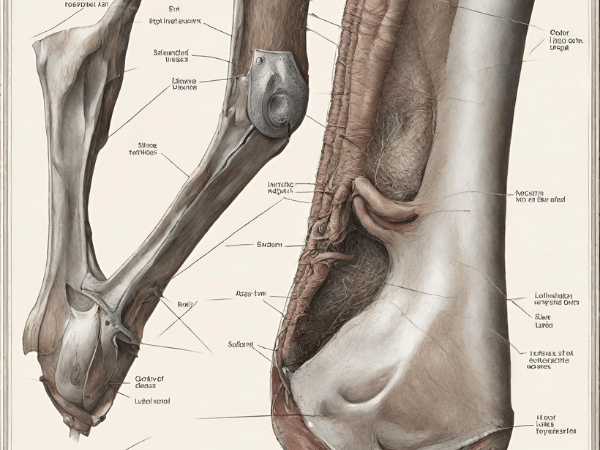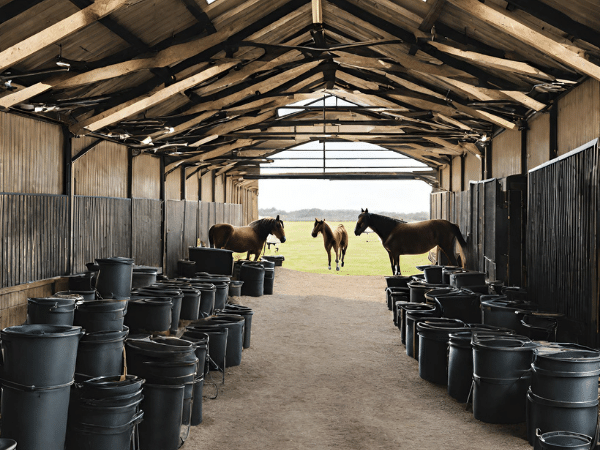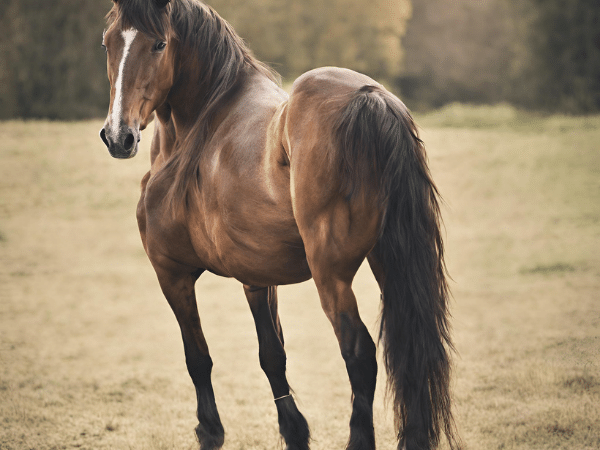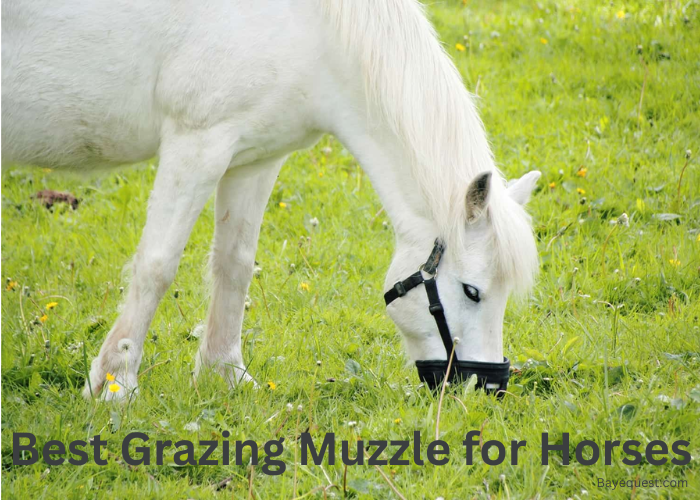Did you know that over 60% of lameness in horses is due to arthritis?
As an equine veterinarian with over a decade of experience, I’ve seen firsthand the impact this condition can have. If you’re witnessing your horse struggle with stiffness or pain, you’re not alone.
This article is your guide to understanding and managing arthritis in horses. From cutting-edge treatments to practical management tips, we’ll explore effective strategies to improve your horse’s quality of life.
Let’s dive in.
What is Arthritis?
Arthritis is when horse joints get swollen and sore. It’s common in older horses or those that do a lot of sports because they work hard.
Arthritis hurts and can make it tough for horses to move or do their best.
A few things can cause arthritis in horses:
- Joint injuries
- Infections
- Problems with the immune system
- Mostly, it comes from something called Degenerative Joint Disease (DJD). DJD makes joints inflamed and stiff, making it hard for many horses to move around easily.
What You Need to Know About Degenerative Joint Disease (DJD) in Horses
DJD, also called osteoarthritis, happens when the cartilage in the joints wears down over time. This leads to bones rubbing together, which causes pain and swelling.
Signs your horse might have DJD include weight loss, areas around the joints being tender or swollen, pain and stiffness in the joints, and lameness that seems to get a bit better after moving around. However, as DJD gets worse, your horse might start feeling pain even when just resting.
DJD doesn’t usually show its true colors until there’s already a lot of damage to the cartilage. That’s why it’s often not caught until it’s pretty advanced, making it a “silent disease” in the beginning.
Acute arthritis is different because it shows up suddenly and causes quick, noticeable pain, unlike the gradual onset of DJD.
Acute vs. Chronic Arthritis in Horses: What to Know
Acute arthritis happens fast, usually right after an injury or infection. It shows up as quick pain and swelling in the joints.
Chronic arthritis, like DJD, takes its time to show up and slowly gets worse. It’s the kind of joint problem that comes from lots of use over many years.
Sometimes, if the cartilage gets damaged or the bone changes because of that first injury or infection, acute arthritis can turn into the chronic kind. This means a short-term problem can become a long-term one if it’s not taken care of right.
Signs of Joint Inflammation and Arthritis in Horses
The most common signs of arthritis in horses are joint stiffness, lameness, reluctance to move, and lessened performance.
Other signs include:
- Muscle loss
- Less movement in the joints
- Swelling from extra joint fluid
- Changes in behavior, like not wanting to exercise or being irritable
If you think your horse might have arthritis, it’s important to talk to your vet right away. Arthritis gets worse over time, and quick care can help slow down joint damage.
Treating both chronic and acute arthritis quickly helps your horse feel less pain and have a better chance of a good outcome.
Diagnosing Arthritis in Horses
Vets begin diagnosing arthritis in horses with a physical exam and flexion tests to assess joint function and range of movement.
They look for joint pain, heat from inflammation, and signs of injury or discomfort. The vet also observes the horse’s movement, either while riding or on a lunge line, to detect any lameness.
After the physical exam, additional tests are conducted to confirm joint issues, which might include:
- X-rays of the joints
- Ultrasound
- CT scan or MRI
- Arthroscopy (using a camera to look inside the joint)
- Blood tests
- Analyzing joint fluid
These tests help confirm the presence of arthritis.
Treating Arthritis in Horses: Effective Approaches
There are many ways to help horses with arthritis, including different therapies and medicines.
Options include:
- Therapy with pulsed electromagnetic fields (PEMF)
- Massage
- Giving the horse time to rest and relax
- Medicines that reduce inflammation but are not steroids (NSAIDs)
- Injections with corticosteroids
- Medicines you apply directly to the skin
- Supplements to support joint health
Next, we’ll provide more details on each of these treatments.
PEMF Therapy for Horses

PEMF, short for Pulsed Electromagnetic Field therapy, is a gentle and non-invasive way to help horses heal. It uses magnetic pulses to work its magic, sending them through the horse’s body in specific patterns.
PEMF is great for arthritis because it:
- Lowers swelling
- Boosts blood flow
- Triggers endorphins, which ease pain
- Helps repair damaged cells
- Makes joints work better
So far, PEMF doesn’t have any known bad side effects. It’s safe to use it with other arthritis treatments, like medicines or health supplements. But, it’s always a good idea to talk with your vet before starting PEMF.
You can do PEMF with different tools like boots, wraps, pads, or handheld devices. Some tools also have extra features, like light therapy or massage, for more benefits.
Massage for Horses with Arthritis
Massage boosts blood flow to the sore joint and the area around it. This can ease pain and swelling.
A professional or the horse owner can do the massage. If you’re doing it, be gentle. Don’t press too hard on the sore spot to avoid causing more pain.
If you’re not sure how to massage your horse, you can look up how-to videos and articles online. You can also ask your vet or a horse massage expert for tips.
Some vets suggest using special massage tools for horses, like massage blankets and handheld devices. These can help with arthritis pain in horses used for sports.
Massage blankets, like the Activo-Med Combi Pro II Blue Therapy System, give deep pressure and stimulation from head to tail. This blanket also has extra features like PEMF therapy, which helps with circulation and makes your horse more comfortable and flexible.
Rest and Recovery for Horses with Arthritis
Rest is really important for all horses, but even more for those with arthritis. It helps their bodies heal and fix themselves. Some horses might need a long break to get better from injuries or infections. But, too much rest can make them sore and lose muscle.
The goal is to find the right balance. Your horse should rest enough to recover but not so much that they get stiff or sore. Always talk to your vet before changing how much your horse exercises. They can help you figure out the best amount of rest for your horse’s arthritis and other health issues.
Using NSAIDs for Arthritis in Horses
NSAIDs are medicines that help with swelling and pain. They are often used for horses with arthritis. These medicines can be given by mouth or injected into the joint.
The most common NSAIDs for horses with arthritis are phenylbutazone (Bute), flunixin meglumine (Banamine), and ketoprofen. They work well because they target the swelling that causes a lot of the pain in arthritis.
NSAIDs can sometimes cause stomach ulcers. It’s important to talk with your vet about the good and bad points of these medicines before you start giving them to your horse.
See also: How Many CC of Banamine Should a Horse Get?
Corticosteroid Injections for Horses with Arthritis
Corticosteroid injections are a common way to treat arthritis in horses. They can be given right into the joint, into the fluid around the joint, or into the horse’s muscle.
These injections help bring down swelling. They’re often used for arthritis because they can keep pain and swelling away for longer than NSAIDs. Horses usually get a steroid shot into the fluid around the joint every 6 to 12 months to control swelling.
But, there are some risks with joint injections, like possible damage to the joint. So, owners should talk with their vet about the good and bad points before starting this treatment.
Using Topical Medications for Arthritis
Topical medications, like salves and ointments, can help lower pain and swelling in horses.
Salves are put directly on the horse’s skin. Most liniments for arthritis help by increasing blood flow to the area and making it feel cool or warm. This can help bring down swelling and make the horse more comfortable.
Topical medications can help the horse’s muscles and joints feel better, but it’s important to use them as directed and not too often to avoid irritating the skin.
Before using liniments or any other treatment, always talk with your vet to make sure it’s safe and right for your horse.
Joint Supplements for Horses
Good food is important for health. Supplements can slow down arthritis and make horse joints work better. These supplements usually come as capsules.
- Glucosamine and Chondroitin: These are in many horse joint supplements. They help keep joint cartilage healthy and reduce swelling.
- Hyaluronic Acid: This helps keep joints smooth and less painful.
A good joint capsule can help horses with arthritis. It might even delay the need for stronger medicine. Joint capsules can also help prevent arthritis in horses that might get it.
Surgery for Arthritis
Surgery to fuse the joint is an option but usually only when other treatments haven’t helped.
This surgery is often done on the horse’s hock or fetlock joints. These are common spots for arthritis. The goal is to stop the horse from moving the sore joint. This should help reduce pain and swelling.
Recovery from this surgery can take a few months. The horse will need to rest in a stall during this time. Surgery is usually the last option.
Read also: How to Treat Strangles in Horses.
Daily Care for Horses with Arthritis
Taking care of a horse with arthritis can be hard. But, daily care, along with treatments and therapies, can make your horse feel better each day.
Keep Moving
It’s important to keep your horse moving, even if they have arthritis pain. Gentle exercises like lunging and light riding are good. They help keep the joints moving and can even lessen swelling if done right.
Always talk to your vet before you start any new exercises with your horse. They can tell you what’s best, usually easy exercises that don’t push your horse too much. This means short rides at a slow pace, with good warm-up and cool-down times to keep their joints feeling good.
Turnout Time for Arthritic Horses
Turnout is great for horses with arthritis. Being outside, breathing fresh air, and moving around freely can really help reduce their pain and stiffness. It also makes them feel happier.
Try to let your horse out for a few hours each day. If you can’t do it every day, make sure they get some time in a pasture or paddock to move around freely. But, be careful when they’re out with other horses. Getting stepped on or kicked can make their arthritis worse. Rough play or fights can also hurt their arthritic joints.
Stable & Yard Care: Essential for Horse Health

The state of the stable or yard affects your horse’s health, especially their joints. A clean, dry stall is important. It gives your horse a safe place to rest, which helps prevent joint problems.
Make sure the floor and bedding can support your horse’s weight and are soft enough to ease pressure on their joints. Keeping the stall clean is key to stop bacteria or fungus that could harm your horse’s health.
Consulting a Professional on Your Horse’s Diet
A diet full of omega-three fatty acids, antioxidants, and key nutrients is crucial for your horse’s joint health and to lower inflammation.
It’s a good idea to talk to a vet or a horse nutrition expert to find the best diet for your horse. They can make a diet plan that fits your horse’s health needs. This helps keep your horse healthy and manage their weight. They might also suggest adding supplements for even better joint care.
Regular Hoof Care is Key
Looking after your horse’s hooves regularly is a must for their health. Good hoof care lessens joint stress and stops problems like lameness, which can happen if hooves are in bad shape or too long.
Find a farrier who knows how to handle horses with joint issues, like arthritis. Their expertise in trimming or shoeing will make a big difference in your horse’s comfort and ability to move around.
Prognosis for Horses with Arthritis
Horses with arthritis, whether it’s a new issue or an ongoing problem, can have a good quality of life with the right treatment. With proper care, many horses live comfortably despite arthritis.
Arthritis gets worse over time. It’s a condition that breaks down the joints gradually. Older horses are especially at risk because they’re more likely to have health problems due to their age.
Catching arthritis early is key to managing it well. If you think your horse might have arthritis, see a vet right away. They can tell you how to best treat it. Following their treatment plan closely is crucial for your horse’s health. Making changes, like adjusting how often your horse goes outside, can also help ease pain and improve how well their joints move.
Taking steps to prevent joint problems is important. You can slow down arthritis and stop other health issues by looking after your horse’s joint health from the start.
Read also: Ways of building a horse’s topline.
FAQs on Joint Inflammation and Arthritis in Horses
This section answers common questions from horse owners about joint problems.
Can Arthritis in Horses Be Cured?
There isn’t a cure for arthritis in horses, but there are many treatments that help a lot with the pain and swelling. If you take good care of a horse with arthritis, it can still have a happy life and keep riding. Arthritis usually gets worse over time, and it’s more common in older horses. The main goal is to make the horse comfortable and keep it healthy, not to cure the disease.
Invisible Arthritis
Sometimes, a horse with arthritis doesn’t show it. They might not limp or look sore even if they have joint disease. Arthritis can be hard to spot early on, even with X-rays. If you think your horse might have arthritis, it’s important to have a vet check it out thoroughly. They can use more than just X-rays to find arthritis.
Preventing arthritis is very important, especially because it can be hidden. Starting early with good joint care can really help lower the chance of your horse getting arthritis later. This helps your horse stay healthier and happier.
Preventing Arthritis in Horses
To keep arthritis away from horses, focus on keeping their joints healthy, exercise them right, and feed them properly. Avoiding injuries is also important because they can lead to arthritis.
Make sure where your horse lives is clean and safe. This helps prevent injuries and sickness.
Looking after their hooves regularly is key.
Feed your horse food that keeps them in good health and weight.
Don’t push your horse too hard. The right amount of exercise is important.
A good weight is crucial to keep the pressure off their joints.
If your horse gets hurt or shows signs of limping, see a vet as soon as you can. Dealing with problems early can keep them from getting worse. Quick care after an injury or when arthritis signs first appear usually leads to better health.
How Do You Treat Arthritis in Horses: Conclusion
Arthritis gets worse with time, but you can still make a big difference for a horse with this condition. Today, we have many ways to treat arthritis, helping horses stay active.
Start by getting a clear diagnosis from a vet. They’ll help make a care plan that’s right for your horse. This might include changes in diet, how much exercise they get, how you look after their hooves, and possibly even medication or other treatments.
By taking good care of them, you can help ease your horse’s pain and keep them happier. This lets you enjoy more time with your horse.








